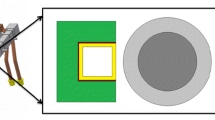Abstract
The main deficiencies of existing induction crucible furnaces are associated with elevated wall thickness of the lined crucible, the tubular copper single-layer inductor (with internal cooling by conditioned water), and the absence or presence of surrounding vertical I-shaped composite metal rods, forming a discrete ferromagnetic screen. The first deficiency is that much of the working electromagnetic flux Φwo is wasted, since it passes along the crucible lining, which is not electrically conducting, rather than along the furnace charge. Only 38.5–57.0% of Φwo is utilized. The second deficiency is associated with the high cost and laboriousness of manufacturing the inductor turns from special copper pipe, which vibrates at double frequency. That creates noise and weakens the furnace structure. Such inductors are characterized by low electrical efficiency and high costs of preparation and cooling of the conditioned water in systems of area several times greater than the furnace itself. The consequence of the third deficiency is that much of the electromagnetic scattering flux Φsc is not involved in heating the batch and the melt but instead heats the electrically conducting elements of the furnace, including the magnetic rods that surround the inductor. Because of the poor utilization of the total flux Φ generated by the inductor, the efficiency is decreased practically to 19–30%, while the power factor falls to 0.03–0.10, with increase in the energy consumption. To minimize or eliminate the deficiencies, three modifications are proposed: decrease in the sleeve’s wall thickness, with simultaneous strengthening by installing a cylindrical shell between the crucible and the inductor; introduction of a magnetic ring around the inductor; and the use of a single-wire or multicore inductor, instead of a tubular inductor. The combination of a cylindrical shell, a magnetic ring, and upper and lower housing plates permits the formation of a closed annular cavity where the inductor may be placed, with cooling of the inductor and the magnetic ring by circulating fluid. On the basis of research, a new design of an induction crucible furnace with a wire inductor and a composite magnetic ring (magnetic core) has been developed at Polzunov Altai State Technical University, tested, and patented. In experiments, the efficiency of the proposed structural elements is confirmed, indicating that the design merits further study.



Similar content being viewed by others
REFERENCES
Farbman, S.A. and Kolobnev, I.F., Induktsionnye pechi dlya plavki metallov i splavov (Induction Furnaces for Metals and Alloys Melting), Moscow: Metallurgiya, 1968.
Issledovanie i razrabotka induktsionnykh plavil’nykh pechei (Research and Development of Induction Melting Furnaces), Prostyakov, A.A., Ed., Moscow: Energoatomizdat, 1986.
Romanov, L.M., Boldin, A.N., Grablev, A.N., and Mikhailov, D.P., Elektricheskie pechi dlya vyplavki chernykh i tsvetnykh splavov (Electric Furnaces for Melting Ferrous and Non-Ferrous Metals), Moscow: Mosk. Gos. Ind. Univ., 2007.
Piterek, R., A career in the service of inductive melting, Cast. Plant Technol. Int., 2013, no. 3, pp. 18–21.
Sovremennye plavil’nye agregaty (Modern Melting Units), Moscow: Metallurg-Konsalting, 2014.
Vellen, T., The bright word of metals shines brighter than ever, Cast. Plant Technol. Int., 2015, no. 3, pp. 46–47.
Piterek, R., Production flexibility combats declining batch sizes, Cast. Plant Technol. Int., 2015, no. 3, pp. 40–44.
Site Inductotherm Europe. http://www.inductotherm.co.uk. Accessed February 2, 2018.
Site Ajax Tocco Magnethermic Corporation. http://www.ajaxtocco.com. Accessed March 12, 2018.
Site Otto Junker GmbH. http://www.otto-junker.com. Accessed March 12, 2018.
Site Induction Technology Corporation. http://www.inductiontech.com/Index.html#top_of_ page. Accessed May 12, 2018.
Site ABP Induction Systems. http://www.abpinduction.com. Accessed May 12, 2018.
Mehr Energieeffizienz für Aluminiumschmelzöfen, Werkstoff Fertig, 2011, no. 3, pp. 39–40.
Chaabet, M. and Dötsch, E., Steelmaking based on inductive melting, Heat Process., 2012, no. 1, pp. 49–58.
Luzgin, V.I. and Petrov, A.Yu., Effective systems and methods of induction melting of metals. http://reltec.biz. Accessed January 20, 2018.
Levshin, G.E., High technology induction melting in induction and electromagnet crucible furnaces, Naukoemkie Tekhnol. Mashinostr., 2016, no. 3, pp. 12–21.
SanPiN 2.2.4.3359-16. Sanitarno-epidemiologicheskie trebovaniya k fizicheskim faktoram na rabochikh mestakh (SanPiN 2.2.4.3359-16: Sanitary and Epidemiological Requirements for Physical Factors at the Workplaces), Moscow: Normatika, 2018.
Levshin, G.E. and Levshin, A.G., RF Patent 177465, Byull. Izobret., 2018, no. 6.
Levshin, G.E. and Matyushkov, I.L., Lit’e v magnitnye formy (Casting into Magnetic Forms), Barnaul: Altaisk. Gos. Tekh. Univ., 2006.
Levshin, G.E. and Levshin, A.G., RF Patent 177475, Byull. Izobret., 2018, no. 6.
Author information
Authors and Affiliations
Corresponding author
Additional information
Translated by Bernard Gilbert
About this article
Cite this article
Levshin, G.E. Improving Induction Crucible Furnaces. Steel Transl. 49, 82–86 (2019). https://doi.org/10.3103/S0967091219020116
Received:
Revised:
Accepted:
Published:
Issue Date:
DOI: https://doi.org/10.3103/S0967091219020116




